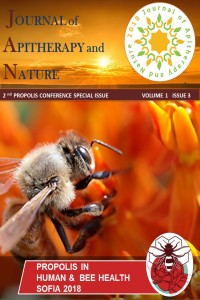Öz
In the framework of our studies on Greek bee-keeping products (honey, The studied It is also noteworthy, the isolation of unedone and |
Anahtar Kelimeler
Kaynakça
- 1. Bianchi F., Careri M., Musci M. (2005). Volatile norisoprenoids as markers of botanical origin of Sardinian strawberry tree (Arbutus unedo L.) honey. Characterisation of aroma compounds by dynamic headspace extraction and gas chromatography-mass spectrometry. Food Chemistry 89:527-532.
- 2. Rosa A., Tuberoso C.I.G., Atzeri A., Melis M.P., Bifulco E., Dessi M.A. (2011). Anti-oxidant profile of strawberry tree honey and its marker homogentistic acid in several models of oxidative stress. Food Chemistry 129:1045-1053.
- 3. Tuberoso I.G.C., Bifulco E., Caboni P., Cottiglia F., Cabras P., Floris I. (2010). Floral markers of strawberry tree (Arbutus unedo L.) honey. Journal of Agricultural and Food Chemistry 58:384-389.
Öz
Kaynakça
- 1. Bianchi F., Careri M., Musci M. (2005). Volatile norisoprenoids as markers of botanical origin of Sardinian strawberry tree (Arbutus unedo L.) honey. Characterisation of aroma compounds by dynamic headspace extraction and gas chromatography-mass spectrometry. Food Chemistry 89:527-532.
- 2. Rosa A., Tuberoso C.I.G., Atzeri A., Melis M.P., Bifulco E., Dessi M.A. (2011). Anti-oxidant profile of strawberry tree honey and its marker homogentistic acid in several models of oxidative stress. Food Chemistry 129:1045-1053.
- 3. Tuberoso I.G.C., Bifulco E., Caboni P., Cottiglia F., Cabras P., Floris I. (2010). Floral markers of strawberry tree (Arbutus unedo L.) honey. Journal of Agricultural and Food Chemistry 58:384-389.
Ayrıntılar
| Birincil Dil | İngilizce |
|---|---|
| Bölüm | 2nd Propolis Conference Special Issue |
| Yazarlar | |
| Yayımlanma Tarihi | 8 Aralık 2018 |
| Yayımlandığı Sayı | Yıl 2018 Cilt: 1 Sayı: 3 - 2nd Propolis Conference Special Issue |
Kaynak Göster
ASOS Index

